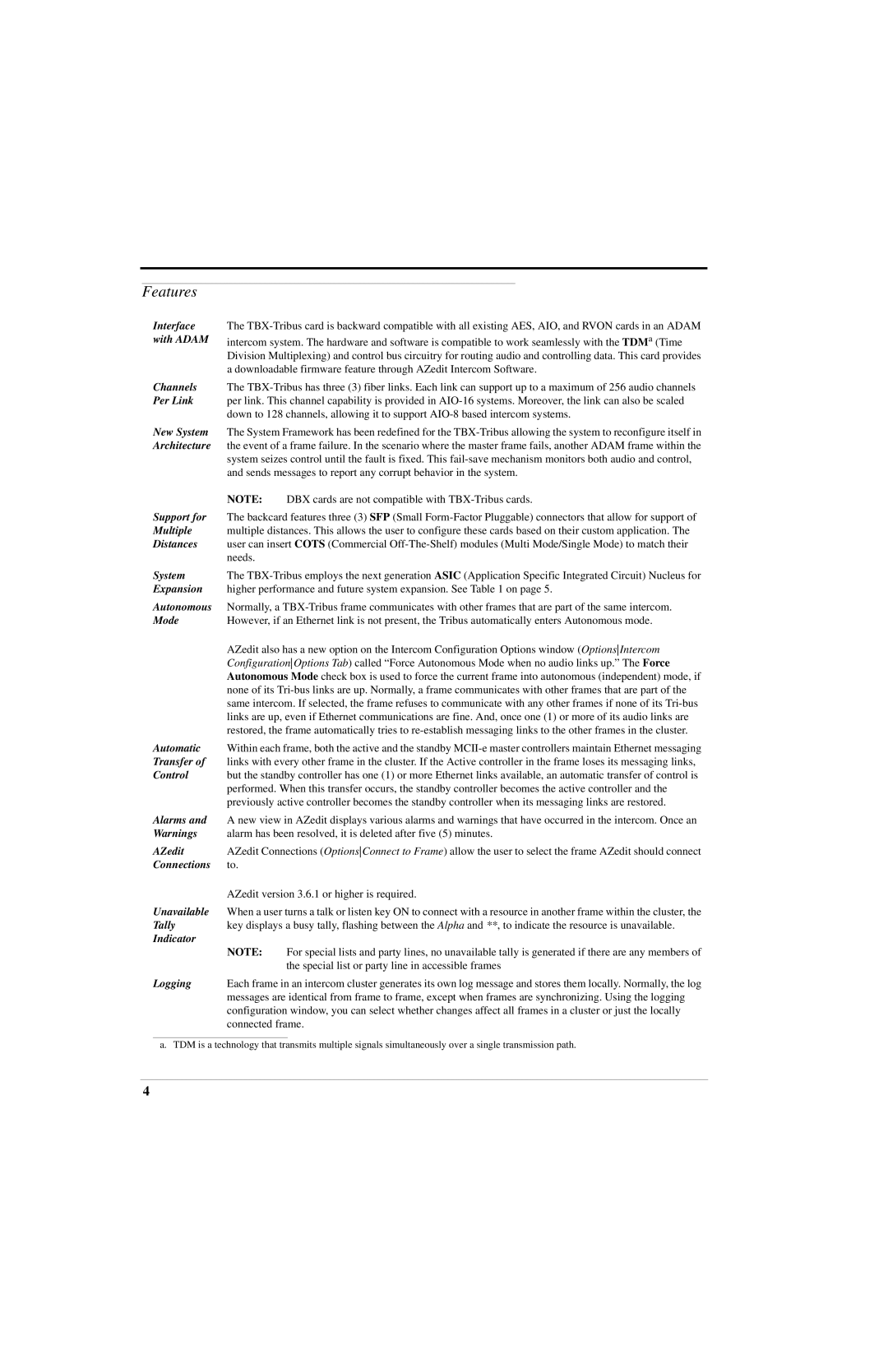
Features
Interface with ADAM
The
intercom system. The hardware and software is compatible to work seamlessly with the TDMa (Time Division Multiplexing) and control bus circuitry for routing audio and controlling data. This card provides a downloadable firmware feature through AZedit Intercom Software.
Channels | The | |
Per Link | per link. This channel capability is provided in | |
| down to 128 channels, allowing it to support | |
New System | The System Framework has been redefined for the | |
Architecture | the event of a frame failure. In the scenario where the master frame fails, another ADAM frame within the | |
| system seizes control until the fault is fixed. This | |
| and sends messages to report any corrupt behavior in the system. | |
| NOTE: | DBX cards are not compatible with |
Support for | The backcard features three (3) SFP (Small | |
Multiple | multiple distances. This allows the user to configure these cards based on their custom application. The | |
Distances | user can insert COTS (Commercial | |
| needs. |
|
System | The | |
Expansion | higher performance and future system expansion. See Table 1 on page 5. | |
Autonomous | Normally, a | |
Mode | However, if an Ethernet link is not present, the Tribus automatically enters Autonomous mode. | |
| AZedit also has a new option on the Intercom Configuration Options window (OptionsIntercom | |
| ConfigurationOptions Tab) called “Force Autonomous Mode when no audio links up.” The Force | |
| Autonomous Mode check box is used to force the current frame into autonomous (independent) mode, if | |
| none of its | |
| same intercom. If selected, the frame refuses to communicate with any other frames if none of its | |
| links are up, even if Ethernet communications are fine. And, once one (1) or more of its audio links are | |
| restored, the frame automatically tries to | |
Automatic | Within each frame, both the active and the standby | |
Transfer of | links with every other frame in the cluster. If the Active controller in the frame loses its messaging links, | |
Control | but the standby controller has one (1) or more Ethernet links available, an automatic transfer of control is | |
| performed. When this transfer occurs, the standby controller becomes the active controller and the | |
| previously active controller becomes the standby controller when its messaging links are restored. | |
Alarms and | A new view in AZedit displays various alarms and warnings that have occurred in the intercom. Once an | |
Warnings | alarm has been resolved, it is deleted after five (5) minutes. | |
AZedit | AZedit Connections (OptionsConnect to Frame) allow the user to select the frame AZedit should connect | |
Connections | to. |
|
| AZedit version 3.6.1 or higher is required. | |
Unavailable | When a user turns a talk or listen key ON to connect with a resource in another frame within the cluster, the | |
Tally | key displays a busy tally, flashing between the Alpha and **, to indicate the resource is unavailable. | |
Indicator | NOTE: | For special lists and party lines, no unavailable tally is generated if there are any members of |
| ||
|
| the special list or party line in accessible frames |
Logging | Each frame in an intercom cluster generates its own log message and stores them locally. Normally, the log | |
| messages are identical from frame to frame, except when frames are synchronizing. Using the logging | |
| configuration window, you can select whether changes affect all frames in a cluster or just the locally | |
| connected frame. | |
a. TDM is a technology that transmits multiple signals simultaneously over a single transmission path.
4
